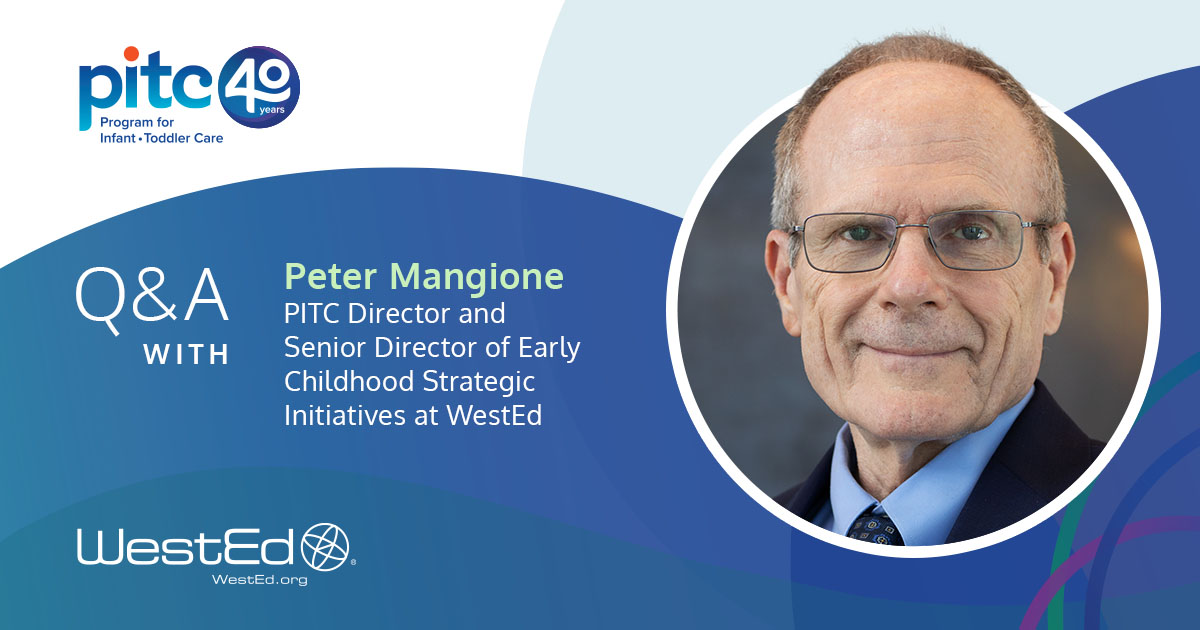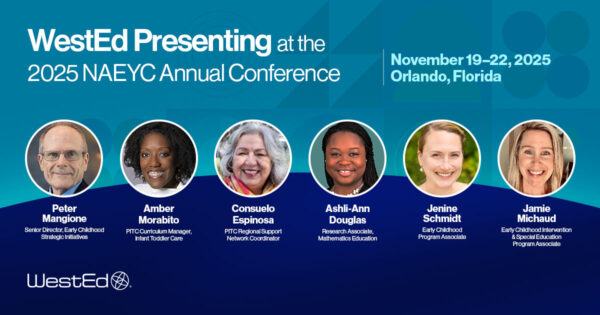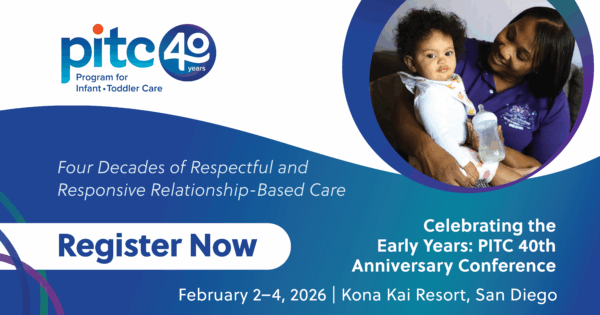
November 17, 2025
Next year marks 40 years since the launch of the Program for Infant/Toddler Care (PITC). What began as a small collaboration between the California Department of Education (CDE) and WestEd has grown into a movement that has transformed the way infants and toddlers experience care across California and beyond.
When it was founded, the PITC set out to address a crucial question: How can we meet the unique needs of infants and toddlers in group care settings at scale? To answer it, a team of child development and family researchers, early care experts, and media specialists came together to design one of the first multimedia training systems for infant and toddler care providers.
Since then, the PITC has become California’s leading provider of professional learning for infant/toddler care, offering training and resources that have reached early childhood professionals and programs across the United States and even other countries.
The PITC was founded by the late Ron Lally and Peter Mangione, who, together with the CDE, built the program on a foundation of respectful, responsive, relationship-based care—a philosophy that remains central to its work today. Mangione is Senior Director of Early Childhood Strategic Initiatives at WestEd and PITC Director. In this candid Q&A, he reflects on the PITC’s origins, its lasting influence, and his hopes for the field of early care and learning.
Note: This interview has been edited for length and clarity.
We began in 1985 as a partnership with the California Department of Education. Collaboratively, we planned for statewide impact but soon recognized an opportunity to expand further. From there, working with national foundations such as the Carnegie Corporation, the Ford Foundation, and the Smith Richardson Foundation helped to expand our reach. Presenting our work at major national conferences also helped us connect with leaders across the country who expressed interest in having us come do training with them.
As the PITC’s cofounder, Ron Lally played a pivotal role in shaping the Early Head Start initiative. Our team, in collaboration with ZERO TO THREE, was selected to lead the Early Head Start National Resource Center. Through the Center, we also reached people from all over the country.
From there, we expanded our early childhood training programs to 22 states and overseas, with study tours and collaborations in countries such as Australia, Singapore, China, and Italy. Each partnership brings new energy and learning and has shaped the PITC into a community that stretches far beyond where we started.
What’s exciting is how our work has continued to grow.
Responsive caregiving is at the heart of the PITC’s work. It’s more than following the child’s lead; it’s about truly knowing each child through building strong relationships, not just with the child but also with their family. Understanding the child’s experiences, communication styles, and family practices helps caregivers interpret what children are expressing and respond in meaningful ways.
Responsive caregiving begins with open observation and reflection—considering what is happening in the moment and the broader context of each child’s day and interactions.
Caregivers need to be willing to reflect on what the child is communicating, try out different responses, and adapt them based on the child’s needs and interests. Ultimately, it’s the process of building trust and showing the child, “I’m going to be here with you, and we’re going to figure this out together,” even if it takes time to find the best way to support them.
PITC … is a community vision that keeps evolving, reflecting new ideas and voices, and it means something different depending on where and how its respectful, responsive, relationship-based philosophy is put into practice.
Peter Mangione
The first step when we’re relating to infants is to recognize their vulnerability. They need us for food, a safe place to sleep, hygiene, all those basic things. But at the same time, infants are competent and resilient. They have a drive to understand and connect with us. For example, observe a child learning to walk. They’ll stand and then they’ll fall, just learning about balance, and they’ll do it over and over again. All of those moments are learning moments and reflect the competence of the young child.
What we ask people to do with the PITC is to hold in mind both ideas at once: Be aware of the child’s vulnerability while supporting their competence. In fact, young children use their growing abilities to address their own vulnerabilities. For example, they work hard to learn language and skills to express their needs and share meaning. Our job is to support that process.
Wherever infants and toddlers are—whether at home, with relatives, in family child care, or in a center—the most important thing they need is a predictable relationship, one that the child can feel secure in and emotionally connected to. And that comes through interaction after interaction, message after message that we give children that “we’re here with you,” that “we’re excited about who you are,” and “you should have a sense of wonder about how you’re developing.” There’s a sense of joy, connection, and warmth that means so much to the young child developing, and that can happen in any setting.
In the PITC, we emphasize small groups, allowing for intimacy, primary relationships that foster continuity of care, cultural responsiveness, inclusion, and the opportunity for each child to be seen and understood as an individual. Safety, health, and routines are also a big part of supporting growth and learning.
Just as important, responsive caregiving isn’t just a skill—it’s a mindset of ongoing curiosity, openness, and genuine connection. While caregiving routines like diapering or serving meals are essential, they’re also moments to connect, communicate, and educate. Sometimes, people see caregiving as simply a series of tasks; it’s so much more. The PITC aims to help care educators slow down, observe, and respond meaningfully to each child, enriching both the child’s experience and their own. No matter your role or setting, building strong, nurturing relationships should always come first.
The first thing is that there is no one way to care for an infant. Culturally responsive care means truly understanding and supporting the child’s lived experience in their family and community.
Whether a culture emphasizes the family or the individual, being responsive to who a child is and affirming them as they grow into themselves is an essential part of good care everywhere. It’s love, connection, and responsiveness that matter most.
Over the past 40 years, the field of infant/toddler care has transformed. Early on, much of the focus was on stimulating babies with planned activities. But we saw, and research soon confirmed, that supportive, attuned interactions are what truly fuel children’s development. One of the biggest shifts was the recognition that social and emotional growth is just as vital as language and intellectual development. That holistic perspective has become central to the PITC’s approach, and it’s gratifying to see it validated by decades of science.
However, progress in the field has been challenging. When Ron and I began the PITC, we hoped that better policies, smaller group sizes, and more investment in caregivers would follow. In reality, many of those same challenges persist. While programs like Early Head Start make a real difference, broader support for infants, toddlers, and the professionals who care for them still lags behind.
Despite this, I’m encouraged by the dedicated care educators who embrace the PITC’s philosophy and find creative ways to foster connection and quality care, even within imperfect systems. The work is ongoing and sometimes uphill, but the dream remains: that one day our society will truly invest in its youngest children. Until then, the PITC will continue to champion the message and support those making a difference every day.
People will be coming from all around the country and outside the country, all united by a passion to nurture the youngest children. We’ll also hear from some very exciting speakers who will bring a lot of enthusiasm and passion to the topic of infant/toddler development and care.
Along with learning, there will be space for reflection and connection. Whether you’re new to the PITC or have been part of this journey for years, you’ll be invited to share your experiences and listen to others. And as the conference closes, my hope is that everyone leaves feeling energized and ready to continue this important work together.
I want to add that the PITC has always been a partnership—Ron and I may have started it with the California Department of Education, but its direction has been shaped by many: the California Department of Social Services, our advisors, faculty, and everyone who has participated in the PITC community over the years. It’s a community vision that keeps evolving, reflecting new ideas and voices, and it means something different depending on where and how its respectful, responsive, relationship-based philosophy is put into practice.
The PITC isn’t a fixed program; it grows with the people who work with it. Even though we haven’t seen sweeping societal change yet, I’m humbled by the many stories from individuals who say the PITC has changed the way they approach their work and even their lives. That kind of impact is what keeps us going.
We thank Peter Mangione and the entire PITC team—both present and past—and everyone who has contributed to PITC’s mission to enhance the lives of infants, toddlers, and their families.
Celebrating the Early Years: PITC 40th Anniversary Conference
For 40 years, the Program for Infant/Toddler Care (PITC) has set the standard for respectful, responsive, relationship-based care. Join us to commemorate this milestone!
Ready to Improve Early Care Practices and Programs?
Are you an infant and toddler care educator, program leader, or administrator looking to improve daily practices and overall program quality? The PITC offers research-based, in-person, and virtual professional learning for early childhood providers across all care settings. Learn how to provide respectful, responsive, and relationship-based caregiving to help young children and their families thrive.












